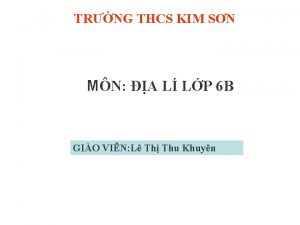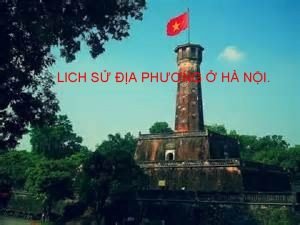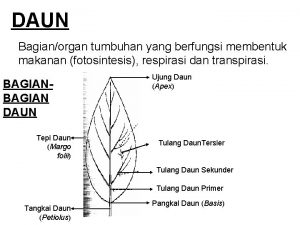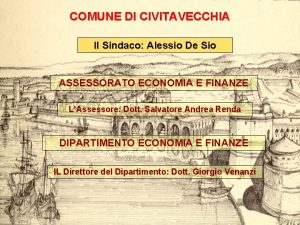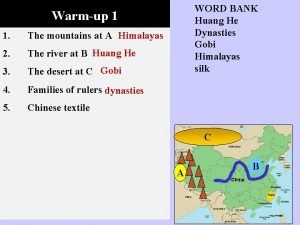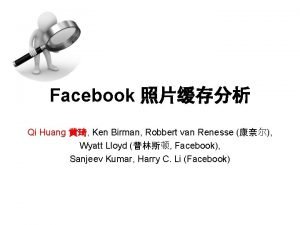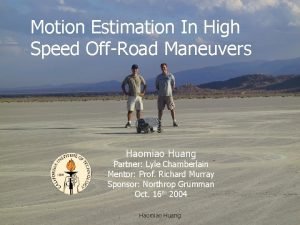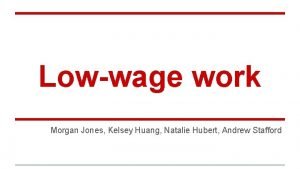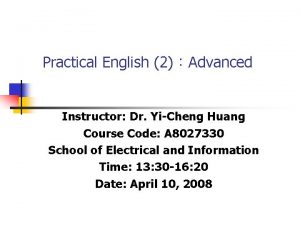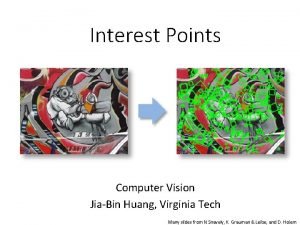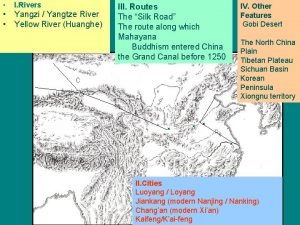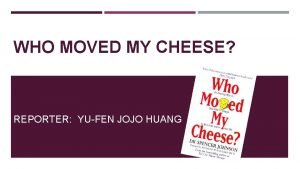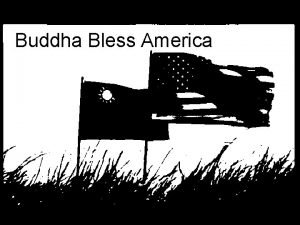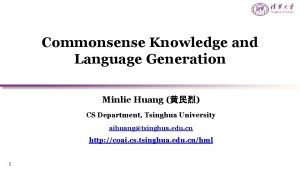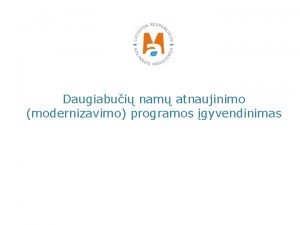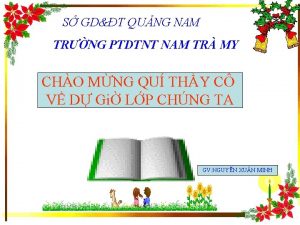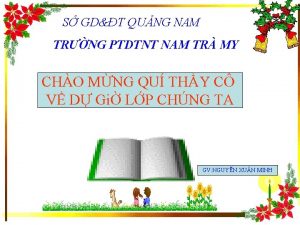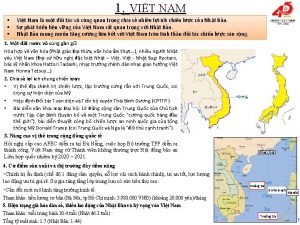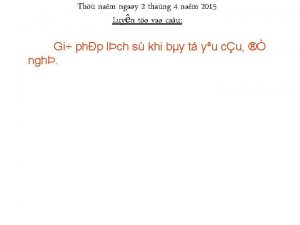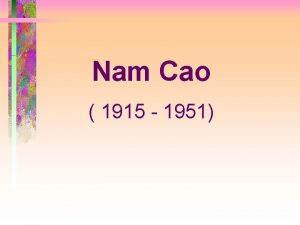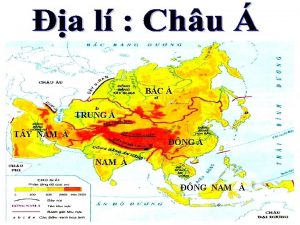Andrea Nam Ayush James Hooi James Huang Alessio




























- Slides: 28

Andrea Nam, Ayush, James Hooi, James Huang, Alessio, Vicky Lee, Sau Gwan Chan, David

THE CAUSES OF THE LONG MARCH THECAUSESOF OFTHE THELONGMARCH

THE CAUSES OF OF THE LONG MARCH • The Long March was caused mainly because of Chiang Kai Shek’s hatred of communism. • After the Communist-Kuomintang split, communists retreated to Jiangxi, and within a few years of arriving, they had gained the support of the peasants under their rule, mainly because of the land redistribution, which allowed millions of poor peasants who had never owned land before become land owners and their own masters, and also because they had reduced taxes, set up schools and peasant councils. Also, the red army members acted courteous and disciplined to the peasants, which played an important part of gaining the peasant’s support. .

THE CAUSES OF OF THE LONG MARCH • In Chiang Kai-shek's point of view, the area in which he found the most threat in was the Jiangxi Province, where many Communists were living. He launched four extermination campaigns, and they all failed because they all had the same tactics. • However, the fifth campaign was different. He used a new strategy to attack the communists, thought up by a German military advisor, General Hans von Seeckt. The plan was successful, and on October 1933, the blockhouse strategy began. . Hans Von Seeckt, KMD’s military advisor from Germany

THE CAUSES OF OF THE LONG MARCH • The Communists had succeeded in surviving through the first four extermination campaigns. Their method was to lure the Kuomintang into a small area by retreating and then attacking them so as many as possible would be killed in a concentrated space. However, as Chiang launched the fifth campaign, the Communists changed their tactics. • Otto Braun was a soviet advisor who was living with the Communists in the Jiangxi province. He was convinced that Mao, part of the Communist Central Committee, had the wrong tactics. Otto Braun, the Communists’ military advisor sent from the

THE CAUSES OF OF THE LONG MARCH • The fifth extermination campaign was so successful mainly because the Communists had an incompetent military advisor, Otto Braun, who recommended new tactics: to defend their borders by fighting head on with the KMD instead of using Mao’s cowardly tactics. • However, Otto Braun’s tactics led to a loss of soldiers and weapons that could not be replaced because of the blockhouses that cut them off from the rest of China. • Mao and Braun disagreed with each other because they each had different ideas which they thought were the best. In Braun’s point of view, Mao’s tactics went against the Communist belief. When they retreated inside the province, they would leave the outer-lying houses helpless and vulnerable. Although this action helped them survive the campaigns, the innocent villagers would be killed or starved to death. This tactic was also hailed as cowardly, and eventually Mao was expelled from the Central Committee.

THE CAUSES OF OF THE LONG MARCH • Otto Braun's tactics cost many lives. The Communists were severely short of supplies due to the blockhouse rings that continuously cut them off from the rest of China. By the summer of 1934, the Communists were trapped inside the heart of Jiangxi, surrounded by multiple layers of Kuomintang blockhouses. • In order to survive, Mao suggested that they should break out of the blockhouses and attack the KMD from the rear, but his voice was ignored, and Otto Braun planned a retreat to the Communist base of the border of Hunan and Hubei where their second red army group was based. • By the beginning of October 1934, around 87000 soldiers had started the retreat planned by Otto Braun. They took all the equipment needed to set up a new government, including printing presses, radio equipment and gold bars etc. In addition, they also carried with them as much weaponry as they could. • The equipment would be greatly useful, either on the march or in setting up a new government. However, they carried much of the equipment on their backs, which slowed the Red Army greatly. It took them six weeks to break through the blockhouse rings, and they were attacked as soon as they had broken through.

THE KEY FEATURES OF THE LONG MARCH

What happened in the first six weeks of the Long march? -It took the Red Army 6 weeks to break through the blockhouses and when they did manage to do so, they were met with the GMD and were forced to fight a major battle at the Xiang River that made them lose almost half their men. -Half of the original 83000 communists who left Jiang Xi died due to various reasons; majorly because of the extermination campaign. -The communists went through many different provinces like Hunan, Guangxi and Guangdong.

• They blamed Otto Braun because it was his easily counter-able tactics that led to an immense loss of communist lives. He had led the Red Army in a straight line that allowed the GMD to predict their actions, and it was because he told them to take too much useless equipment, such as printing presses and furniture, that slowed them down when they could have escaped. • At the Zunyi Conference Mao Zedong was elected chairman of the CCP and Otto Braun was suspended.

• He turned a cowardly retreat into a source of pride for the communists through misdirection (Lying/propaganda) • Mao led the Red Army on the route that twisted and turned so that the GMD would not be able to predict their route.

They outsmarted the GMD, who were busy occupying ferries by pretending to build a bridge while actually they sent a small group of soldiers to secure and assault some of the GMD soldiers and capture their ferries.

• The Long March was halted by the river which was swollen with water and harried by the GMD air force so they tried capturing the Luding suspension bridge, but to their dismay it was badly damaged and inoperable and so they had to assault it. • 22 soldiers swung across the river gorger with the chains which were all that were left of the bridge, whilst under enemy fire, which allowed the rest of the red army to pass through.

• At the snowy mountains the men had to cross peaks up to 4800 m high and even in the summer many of the southerners died of hypothermia. They were caught in a terrible hailstorm that froze them men whenever they rested or sat down. • At the grasslands the army was beleaguered by the large amount of swamps and quicksand pits causing a large loss of life by both illness and other means. There were large amounts of mosquitoes which made the men’s faces black and their bodies weak. The swampy water smelled horrible and made people vomit.

• The GMD leaders had not been swayed by the fact that the CCP successfully crossed through the Chang Jiang River, but in fact, the CCP had fallen into enemy territory. Not the GMD, but in an area where a primitive tribe, the Lolos. • The CCP had to pass through this area, but the Lolos were not willing to let them through. It was only after the CCP decided to bribe them with money and weapons, did the Lolos let the Red Army through.

• The Long march ended in October 1935 at the Red Army base in Shaanxi province.

• Miles covered: around 8000 miles covered in less than 370 days • Communists Army Strength (Oct 1934): Approximately 86, 000 • Communist Army Strength (Oct 1935): Approximately 7000 • Chinese Nationalist Party Army Strength: Approximately over 300, 000

THE CONSQUENCES OF THE LONG MARCH THE CONSEQUENCES OF THE LONG MARCH

The Consequences of the Long March • As result of the Long March, over 7700 soldiers of the Red Army died, but the Communists were not exterminated. • The Long March bought the CCP to a place of enough isolation that gave them the isolation it needed to recuperate and rebuild itself in the north of China. CCP gained a positive reputation from the determination and dedication of the surviving participants, and spread communism over the Long March through introducing land reform, promising equality and promoting women’s rights. Mao's position as the undisputed leader of the CCP solidified because of the Long March.

The Consequences of the Long March THE GMD’s VIEW OF THE LONG MARCH • Otto Braun sent the Red army to march in a straight line. The GMD were able to predict where the Red Army’s would move next. • When they reached to Zunyi the communist party agreed to suspended from the control of the ‘Red Army. ’ • When Mao took over he wanted to separate the Red Army and move the army in twisted movement making GMD impossible for them to predict. • The GMD viewed the Long March as a victory. They described it as a ‘long distance campaign to press and annihilate the enemy’ and they did it and got rid of the CCP from the southwest of China so those provinces would be under their government’s control.

The Consequences of the Long March MAO’S VIEW OF THE LONG MARCH • Mao viewed the Long March as a great success and this can be interpreted from the speech he made in December 1935 on his views on this particular event in history. According to Mao, the Red Army face much difficulties in their journey including being pursued, intercepted, and even blocked by KMD’s enormous army. However, despite all this, he stated, ‘by using our two legs we swept across an immense distance of more that 10500 Km. ’ He was also extremely proud of their accomplishments, calling the Red Army heroes, and the KMD was powerless. He summarized the long march by calling it a ‘victory for us and defeat for the enemy.

The Consequences of the Long March HISTORIAN’S VIEW OF THE LONG MARCH • Historians have stated that Mao had used the Long March for propaganda, as unlike his claims, the Long March was greatly exaggerated as the distance was a mere 6, 000 km compared to his declaration of it being 10, 500 km. • Two historians include, Ed Jocelyn and Andrew Mc. Ewen, two British researchers, who personally retraced the Long March route in order to prove the genuineness of Mao and the CCP’s claims, quite contrastingly found that as mentioned above, Mao had almost doubled the length of the Long March in his story. • In conclusion, historians believe that the Long March was not as great as it was said to be and question it’s authenticity.

The Consequences of the Long March THE CCP’s VIEW OF THE LONG MARCH • They saw it as a glorious victory march towards freedom from oppression, an honourable retreat that did not use cowardly tactics and let innocent peasants die. • The red army played a large role in the retreat through harassing the GMD and retrieving firearms from Jiangxi province for use against opposing armies. • The Great March also brought about the unification of the red army, although a large portion of them died off during the march. • The march helped the CCP gain popularity among the Chinese peasants, ultimately helping the party to power in the end.

The Consequences of the Long March THE CCP’s VIEW OF THE LONG MARCH • In the aftermath of the long march, the Communist party had plenty of isolation and time to recover and rebuild in their new position. • It also gave the CCP a great position to escape into the communist soviet union for safety if the GMD tried another extermination campaign.

Before the march. • In October 1933 Chiang began a blockade of Jiangxi stopping movement of essential supplies • With 700 000 men Chiang encircled Jiangxi and waited for them to surrender. • In 1934 the GMD controlled most of China and the CCP controlled only four small bases

Military facts. • At the battle of Zunyi the red army lost 45 000 men out of the 87 000. • After the battle the Leaders of the CCP reviewed their policy and blamed Otto Braun for their loss. • Now that the army was deep into the countryside they would be better off with a man of their own and Mao Zedong was elected.

Facts • For the CCP this was a massive and honourable retreat to escape from Chiang army. • Chiang tried to dislodge the CCP from their mountain retreat with four consecutive campaigns. • There a lot of major key bridges and battles along the march.

The views. • The CCP viewed the march completely differently from how the GMD viewed it. • The CCP viewed this movement as a demonstration of vitality by the red army. • The CCP describes their army with a allconquering fighting strength.
 Chí tuyến nam nằm ở vĩ độ nào
Chí tuyến nam nằm ở vĩ độ nào Lịch sử hà nội từ năm 1802 đến năm 1918
Lịch sử hà nội từ năm 1802 đến năm 1918 Izlij duha svoga
Izlij duha svoga Bentuk daun acicular
Bentuk daun acicular Ayush license karnataka
Ayush license karnataka Ayush mithra
Ayush mithra Cpia 4 lazio
Cpia 4 lazio Alessio rocchi
Alessio rocchi Leda speziale san vicente
Leda speziale san vicente D'alessio
D'alessio Alessio
Alessio Alessio mazzotta
Alessio mazzotta Alessio patalano
Alessio patalano Dopolavoro ferroviario
Dopolavoro ferroviario Anagrafe di civitavecchia
Anagrafe di civitavecchia Alessio bocci
Alessio bocci Where is the huang he river
Where is the huang he river Qi huang facebook
Qi huang facebook Haomiao huang
Haomiao huang Natalie hubert
Natalie hubert Yicheng huang
Yicheng huang Jiabin huang
Jiabin huang Jiabin huang
Jiabin huang Jimmy huang nottingham
Jimmy huang nottingham Jiabin huang
Jiabin huang Huang he and yangtze rivers
Huang he and yangtze rivers Cheesereporter
Cheesereporter Buddha bless america
Buddha bless america Minlie huang
Minlie huang
